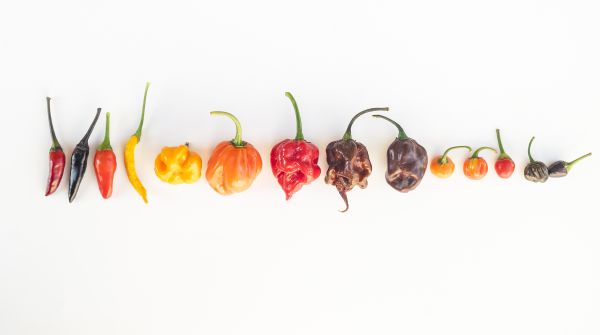Happy 151st birthday to the man who abused his tastebuds in the name of science. Even if you haven’t heard of Wilbur Scoville, you’ve might have heard of the Scoville Organoleptic Test. It’s more commonly known as the Scoville scale today — a standard measure of the perceived heat intensity of chili peppers.
Scoville, a Connecticut-born pharmacist with hair just as cool the Google Doodle above makes it seem, developed his test in 1912 while working at Detroit-based pharmaceutical company Parke-Davis. How it worked: According to ChilliWorld, extract of the pepper being tested was diluted in sugar water until the “heat” of it was no longer perceptible to a panel of testers. Just how much a pepper extract had to be diluted gave it its rating.
If you’re thinking that the methodology sounds imprecise, that’s because it was. Some people are just way more sensitive to heat than others. And what about lingering effects from the last taste test? Or did they wait twenty minutes between each measurement? Maybe they ate Saltines to cleanse the palate?
Of course, the test evolved. Today, capsaicin concentration is typically measured using High Pressure Liquid Chromatography, which separates and measures out the capsaicin in an individual pepper. Sweet peppers have a rating of zero Scoville heat units (SHU), because they aren’t hot at all. On the other end of the scale, pure capsaicin, the compound that gives peppers their burn, has a rating of 6 million SHU. That’s about as hot as it gets.
You may have noticed, though, that not all peppers are created equal—even peppers of the same type. This is due to variations in growing conditions. Temperature, hours of sunlight, soil composition, moisture, and even fertilizer can all affect the final outcome of a pepper’s heat. Habaneros in particular are susceptible to this variation, meaning that they can range from 100,000 SHU to 350,000 SHU.
As for the hottest pepper in the record books, the honor belongs to the Carolina Reaper, a crossbreed between a ghost pepper and a red habanero. At 1.5 million SHU (on average—the hottest pepper in the bunch went up to 2.2 million SHU), the reaper has held the Guinness World Record since August 7, 2013. No doubt some breeder is already out there trying to grow something even hotter.
All this is to say, thank you, Mr. Scoville. You didn’t start the fire, but you did teach us how to measure it.

If you’re a glutton for punishment, check out our roundup of some of the best videos of people eating hot peppers (mostly Carolina Reapers). It’s painful…and often funny.
First, the woman who felt like “doing something rrrreally stupid” to entertain her viewers. This seems to be a common thing among vloggers. Do something stupid, puke, get those views!
In Vegas, people waste money, which leaves them needing money, which leaves the way too agreeable to eating Carolina Reapers for money.
The guy who anticipated that he would “probably cry” after eating ten Carolina Reapers. He undershot the effects dramatically.
The kid with an awesome accent who eats “a Carolina Reaper! A whole one!” and then gets lectured by his dad.
The woman who first tried to tame the heat with a jug of water, and then with Coke. Which didn’t appear to help.
And finally, the father-and-son duo who both eat Carolina Reapers and manage to stay fairly calm, while also eating ice cream straight from the carton. Hey, you can’t blame them. Dairy is the best thing to stop the burn.






